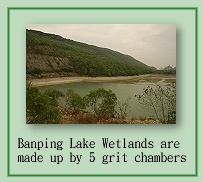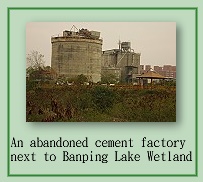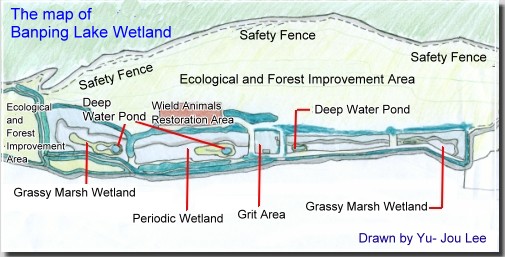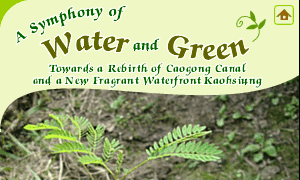
 Back to Back to
Urban Wetland Models
|
Banping Lake Wetland
The Rebirth of Abandoned Mine Areas

There are three limestone geological mountains in Kaohsiung, Banping Mountain, Shou-San Mountain, and Camel Mountain. They used to be an important source for Taiwan's limestone ore. After a long period of mining, the ecosystem experienced serious damage. In 1997, because of the termination of mining rights, the mine areas ceased production andravaged Banping Mountain finally got a chance to recover. Several years later, the government carried out a conservation plan for the water and soil of the abandoned mine areas. After years of restorative afforestation and rehabilitation, Banping Mountain slowly regained its original beauty. carried out a conservation plan for the water and soil of the abandoned mine areas. After years of restorative afforestation and rehabilitation, Banping Mountain slowly regained its original beauty.
In 2004, the Kaohsiung Association of Hydraulic Engineers was commissioned by the City Government to execute an evaluation of the "possibility of using the Chien Tai Cement Company's grit chamber area at the south side of the Banping Moutain also as a wetland park." The result of the evaluation was positive. Hence, in 2005, the City Government budgeted for and built up a nature park at the foot of the northwestern side of the mountain. They also afforested and constructed five flood-detention grit chambers at foot of the southeastern side of the mountain. Man-made wetlands were thus created to effectively function as grit-removal and flood-detention bodies.
Grit Removal, Flood Detention, and the Restoration of the Ecosystem
The long narrow stripe of the Banping Lake Wetland is located between Banping Mountain and the cement factory, having an approximate area of 20 hectares and lying beside the tracks of the northeast-southwest high speed rail. Besides integrating the Banping Mountain Natural Park into a region for stand improvement and wild animal rehabilitation, this area ofabandoned mines also has about 8 hectares of 5 flood detention chambers and is destined for wetland eco-ponds.
During the dry season, parts of the Banping Lake will display a unique feature of limestone deposition and an ecosystem of draught-tolerant plants. Hence, they are divided into "periodic wetlands" and "grassy marsh wetlands." Periodic wetlands can be made into flood-detention wetlands and the places around them can be organized into grassy marsh wetlands, deep water ponds, ecological floating islands, multi-pore wetlands, dead wood piles, and mulch-covers. The hybrid shrubs and mixed dense woods will be used to attract butterflies and birds, and terrace-like bank revetments can provide the growing and breeding environment for reeds and amphibians. Dead wood and floating islands can offer birds a safe habitat, while deep water ponds can give fish a place to stay during the dry season.

The Diversity of the Rich Ecosystem
After the Banping Lake is restored, native water plants will be brought in to increase the biodiversity of the lake and a protective greenbelt will also be constructed around the lake. Native flowering trees like Chinaberries, Pongam Trees, and Guest Trees, and understory plants, such as gemmuliferous Neolitsea auratas, Price's Glossy Privets, Woolly-flowered Persimmons, will all be used to create a multi-layer vegetation greenbelt.
According to research, Banping Mountain has 6 species of mammals, 12 species of spiral shells, 17 species of reptiles, 63 species of butterflies, 72 species of birds, 101 species of insects, and 340 species of plants. From here we can see that, as the Banping Lake wetlands landscape reconstruction finishes, not only do the abandoned mining areas enjoy rebirth, but the ecosystem is also enriched. In the future, rehabilitation will be expanded to reintroduce the sika deer, wild rabbits, Formosan Reeve's Muntjacs, and eagles that once roamed the western plains of Taiwan, into the habitat. Not only will Banping Mountain be a hot spot for hiking for the citizens of northern Kaohsiung City, it will also be a great natural classroom to teach about the ecosystem. Located besides southern Taiwan's transportation center - the Taiwan High Speed Rail's Tzuoying Station, these beautiful wetlands will definitely impress all visitors to Kaohsiung. From the wetland restoration, visitors will see the wonderful transformations of Kaohsiung, praise Kaohsiung's beauty, and truly enjoy the "Fragrant River Banks" of Kaohsiung City!
Banping Moutain's entire ecosystem has been devastated by the mining industry and cannot be restored back to its original state. However, the government still tried to restore the vegetation and prevent mudslides from affecting the livelihood of the people living there by constructed 5 flood-detention grit chambers at the foot of the mountain. Moreover, the government also used the grit chambers as man-made lakes, which are now called the Banping Wetlands, to help restore the ecosystem.
Besides being used for flood detention purposes and as grit chambers, due to the government's active promotion to recreate Banping Wetland's natural landscape, the area has transformed from lifeless grit chambers into wetlands that are home to 3 species of mammals, 12 species of spiral shells, 17 species of reptiles, 63 species of butterflies, 72 species of birds, 101 species of insects, and 340 species of plants.
Located on a mountain, the Banping Lake Wetlands have a peaceful environment for people to visit during weekends and holidays. Moreover, the Wetlands are very easy to find because the High Speed Rail is just at the side! We hope that the ecosystem on the Banping Moutain can be fully restored with the help of the Banping Lake Wetlands and we also look forward to see the results of the City Government's Banping Moutain restoration project.
Reflection
When we saw the Banping Lake Wetlands, it was very hard to imagine how badly the Banping Moutain was devastated by the mining industry. It is with the hard work of the Kaohsiung City Government and environmental organizations that we can have these new wetlands with a rich natural ecosystem. It is a great blessing for Kaohsiung's citizens. As we enjoy the serenity of the Wetlands, don't forget to thank the City Government and conservation groups for their efforts. Hopefully everyone can cherish this beautiful and precious land.
|

